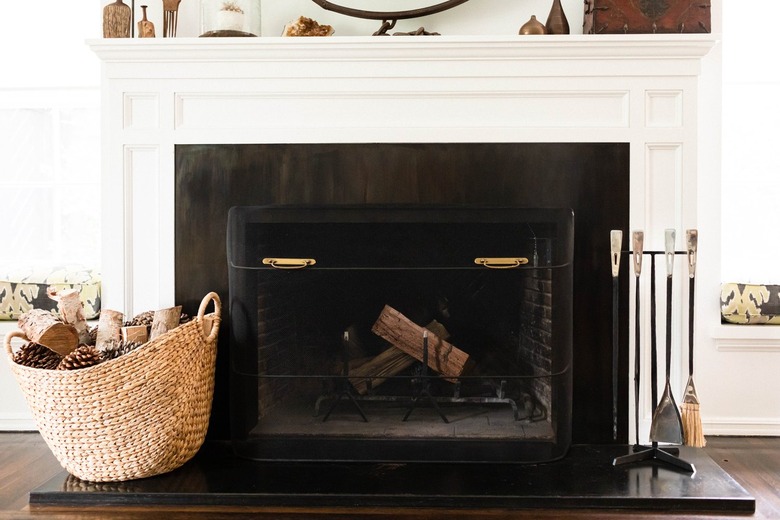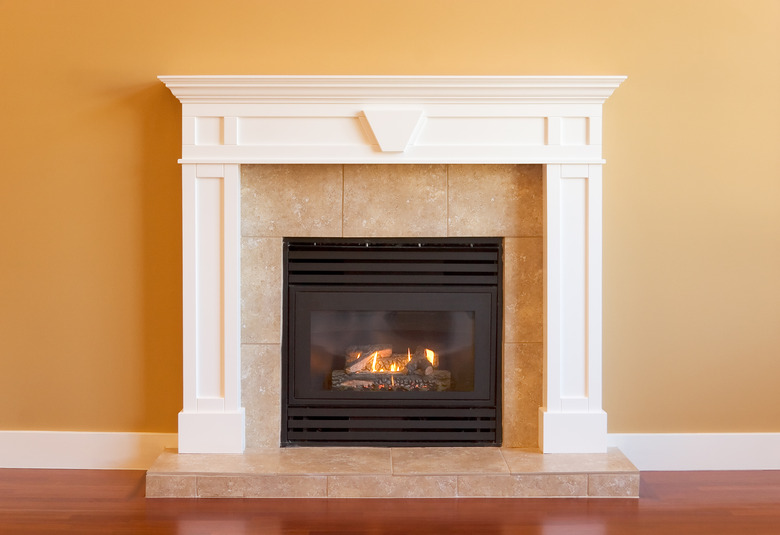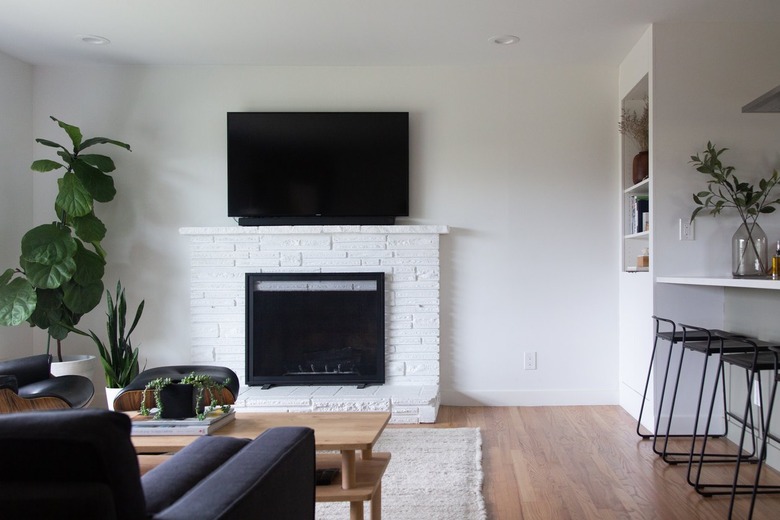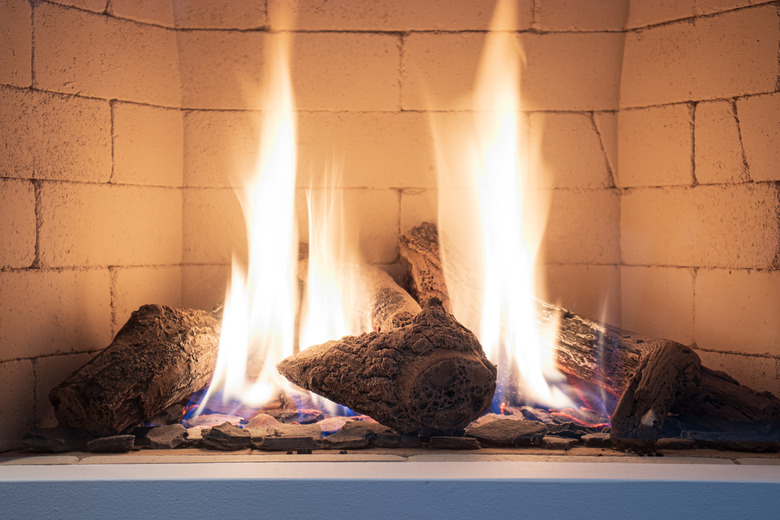How Efficient Are Gas Fireplaces?
We may receive a commission on purchases made from links.
Nothing makes a cold winter evening more enjoyable than watching logs burning in a wood-burning fireplace, but when it comes to heating your home, a gas fireplace is more efficient. Even a gas fireplace with an open flame has a better efficiency rating than a fireplace that burns wood, but a gas unit with an enclosure that isolates the flame in a combustion chamber is radically more efficient. Better efficiency means that more of the fuel that you pay for gets converted into usable heat.
The Energy Efficiency of a Wood Fireplace
The Energy Efficiency of a Wood Fireplace
If you use a conventional wood-burning fireplace for heat, get ready for some bad news: It's only about 10 percent efficient. A cord of firewood, which measures 4 feet in width and height and 8 feet in length and occupies a volume of 128 cubic feet, releases an amount of heat into your home equivalent to only 12.8 cubic feet. In other words, the heat potential from a cord of firewood is equal to a woodpile that measures roughly 2 feet in length and width and 3 feet high.
Where does the heat from the rest of the cord go? It goes out the chimney. A wood fire has to generate an updraft to expel combustion gases through the chimney, and most of the heat the fire generates is caught in the updraft and lost. Combustion byproducts are atmospheric pollutants, and the embers from a burning fire have to be controlled with a spark arrestor to prevent them from starting a fire outdoors.
But that's not all. The updraft creates a vacuum around the fire, and because it needs oxygen for combustion, the fire draws air from the room, creating a convection current that pulls in cold outside air from gaps and cracks in doors and windows. This draft can make you feel even colder than you would if the fire wasn't burning. If you try to prevent the draft by sealing gaps, the fire voids the room of oxygen and can make it hard to breathe. That's a lot of discomfort for the benefit of 10 percent of the heat potential locked into the logs you're burning.
The Gas Fireplace Difference
The Gas Fireplace Difference
No matter which type of gas fireplace you choose, it will always burn more efficiently than a wood fire. Gas flames don't need to burn as hot as wood flames to create the necessary updraft for exhaust, so even a gas flame that draws fresh air from the room won't draw as much as a wood flame. Because a gas fire burns more completely and produces fewer combustion byproducts, more of the combustion heat is available in the living room, bedroom, or wherever the fireplace is located.
Another reason gas fireplaces are more efficient is that you can control combustion. You can adjust the rate of gas flow yourself or connect the fireplace to a thermostat that does it automatically so that the fire will produce only the amount of heat you need at the time you need it. Moreover, you don't have to wait for the fire to heat up. Just turn on the gas, ignite it, and you have instant heat. Wood fires tend to smolder when you light them, and this causes creosote buildup in the chimney. If you don't clean the chimney periodically, the buildup acts like a damper to prevent the fire from getting really hot.
A third advantage of a gas fireplace over a wood fire is that you can install one anywhere, and you don't need to build an expensive chimney. Some gas fireplaces can be vented through a wall with a relatively inexpensive duct system, and some don't need a vent at all. Choosing a gas fireplace doesn't mean sacrificing the ambiance of burning logs because you can install ceramic gas logs in open gas fireplaces as well as fully enclosed gas fireplace inserts. You can fit an insert in your existing fireplace or install it in any place that fits with your home's decor.
Types of Gas Fireplaces and Their Efficiency
Types of Gas Fireplaces and Their Efficiency
Homeowners looking to convert their existing fireplace to gas or install a fireplace in a home that doesn't have one have three basic choices: B-vent, direct vent, and ventless. These progress in order in terms of energy efficiency, with B-vent fireplaces being least efficient and ventless fireplaces being most efficient.
When shopping for gas fireplaces, always check the efficiency rating for each model you're considering. In general, here's the efficiency rating you can expect from each of the three main types of gas fireplaces.
B-Vent
Efficiency rating: 70 – 85 percent
The B-vent fireplace is the one that most resembles a wood-burning fireplace. The flame is open to the room, and it exhausts combustion gases through a double-wall vertical pipe that can be installed inside a regular chimney. Like a wood-burning fireplace, it draws the oxygen it needs for combustion from the room. Homeowners with wood fireplaces often choose to replace them with B-vent fireplaces because they're easy to install inside an existing chimney.
Direct Vent
Efficiency rating: 70 – 90 percent
Direct vent gas fireplaces feature sealed fireboxes or inserts connected to coaxial vents that both exhaust combustion gases and draw in fresh air from outdoors to feed the flames. Unlike the vent pipe for a B-vent fireplace, the vent for a direct vent fireplace doesn't have to be vertical — you can run it horizontally through a wall or route it vertically through the ceiling and change its direction to feed it through a wall above the ceiling. The sealed firebox allows for more complete combustion, eliminates cold drafts in the room, and utilizes almost all the heating potential in the fuel, whether it's propane or natural gas.
Ventless
Efficiency rating: 100 percent
Also known as a vent-free fireplace, a ventless gas fireplace can have a heating efficiency that is close to — or if it's a high-quality one, equal to — 100 percent. The design that allows this is similar to that of a high-efficiency gas furnace. Combustion gases are recycled inside the closed firebox to extract more heat, and the gases that remain — mostly carbon dioxide and water — can be released into the room because they are generally harmless. That's why a ventless fireplace has no vent, and that fact allows you to put one almost anywhere in the house.
Not everyone agrees that ventless fireplaces are safe, and they are prohibited in some states, such as California, as well as in Canada. It's possible that small amounts of toxic gases, such as carbon monoxide, are released from a ventless gas fireplace to negatively effect indoor air quality. And because ventless gas fireplaces release water vapor, they increase the ambient humidity, which can deteriorate drywall and woodwork and promote mold growth.
Tip
Homeowners living in localities in which ventless fireplaces are prohibited can opt for an electric fireplace if they are looking for very high-efficiency heat output. Electric fireplaces are emission-free and have a 100 percent efficiency rating, but they also have a larger impact on heating bills than gas fireplaces.
Gas Fireplace Ignition System Efficiencies
Gas Fireplace Ignition System Efficiencies
A gas fireplace can have one of two types of ignition systems, which have a small but significant impact on its overall efficiency. The most common system is known as a standing pilot, which is a small flame that burns continuously. It outputs about 600 Btu (British thermal units, a unit defined as the amount of heat it takes to raise the temperature of one pound of water by one degree Fahrenheit) of gas per hour, which amounts to 14,400 Btu daily and about 432,000 Btu per month. Natural gas is sold by the therm (1 therm = 100,000 Btu), so this amounts to 4.32 therms per month.
This sounds like it might be a lot, but since the average national price for natural gas in 2020 was only $1.79 per therm, it amounts to a monthly cost of around $7.73, although it could be significantly higher in places like Hawaii (which has the highest gas rates) or lower in places like Idaho (which has the lowest rates). In any case, it's basically wasted heat for which you have to shell out almost $100 annually if you use your fireplace year-round.
The alternative is an intermittent ignition system that employs either an electronic spark ignitor or a hot surface ignitor. Both of these avoid gas wastage and are more efficient, but they require electricity, and if you wire one into the home's circuitry, the fireplace would be out of commission in the event of a power outage. Although they waste energy, standing pilots perform useful functions by burning continuously, not the least of which is that they allow the fireplace to work when the power goes off. Standing pilots also keep the firebox warm and dry, and they keep bugs away and burn off spiderwebs that could clog gas orifices. They do require relighting when they go out, but that's usually a simple procedure described in detail in the owner's manual for the fireplace.




